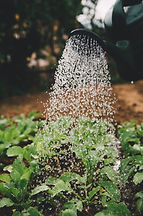SAVE THAT WATER !!



Water is a precious commodity that costs money and, in some areas, is even sometimes rationed. Some might be reluctant to use water for growing food, however food independence is important, so let’s be wise about how we use water!
Here are some tips for being a waterwise gardener:
-
SOIL –When you have friable, living, spongey soil in your garden, you will save water because it will absorb and hold the moisture. (hyperlink to soil section)
-
MULCH – Mulch is an essential element in any garden. Nature dislikes bare soil. A thick layer of mulch will keep water from evaporating, as well as prevent weeds from growing, additionally, if you are using natural mulch, it will break down and contribute to the soil consistency you are striving for. (hyperlink to mulch section
-
TIMING – Water early in the morning or late in the evening. This will decrease the effects of evaporation.
-
IRRIGATION – Use a drip system on a timer whenever possible.
-
DEPTH – Water deeply and less frequently for plant health and growth.
-
WEEDS – Keep your garden well -weeded so you aren’t wasting water growing weeds.
-
PLANTS – Choose drought- tolerant and native plants for areas where you aren’t growing food crops. (hyperlink to native plant section
-
HARVEST WATER

HARVESTING WATER
Catching and storing rainwater has numerous advantages. First, it is a sustainable and eco-friendly way to conserve water. Second, it can help reduce water bills and provide a backup source of water during droughts or emergencies. Third, rainwater is free from chemicals and minerals found in tap water, making it ideal for watering plants and gardens.
Whether you have a lot or a little rain where you live, harvesting rainwater is a great idea. We store around 1800 gallons of rainwater from roof runoff in arid southern California, where we get about 12” of rain on average every year.
For every 1000 square feet of collection area (roof), you can collect 700 gallons of water per inch of rain. That is a surprising amount of water when you think about it!
In houses with gutters, half the work is already done, you just need to guide that rainwater into storage tanks of one sort or another. Go for the maximum amount of storage that you possibly can; it will be worthwhile!


Graywater
Graywater is the used water from your washer, your tub, shower and bathroom sink. (Toilet water is called black water.) You can use graywater for your plants thus conserving water and reducing strain of treatment facilities. The number of homes with graywater systems is increasing daily.
There are simple rules to follow for using graywater:
-
Check with local authorities to be sure graywater is allowed in your area
-
Be careful about the products you use, make sure that you check ingredient labels for salt content and check with a reliable source to ensure the products are safe.
-
Be careful that your plants aren’t getting too much water, careful evaluation of plants water needs is a requirement for using this kind of system.
-
Be sure graywater is used only on ornamentals or fruit trees and not directly on food plants because of the possibility of harmful bacteria, grease, etc.
-
If you are using mulch on your plants that are watered with graywater, be sure to use wood chips and not straw, as straw tends to breed bacteria whereas wood chips will grow fungus.
-
Of course, you can’t drink graywater, and it shouldn’t be allowed in storm gutters.
Graywater systems are plumbed to be able to go either to the sewer or to your plants, so if you need to use bleach in your load of laundry, for instance, you can direct that water into the sewer instead of to your plants. Graywater is never stored; it goes directly onto the ground.


